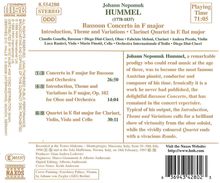Johann Nepomuk Hummel: Fagottkonzert F-dur auf CD
Fagottkonzert F-dur
Herkömmliche CD, die mit allen CD-Playern und Computerlaufwerken, aber auch mit den meisten SACD- oder Multiplayern abspielbar ist.
Lassen Sie sich über unseren eCourier benachrichtigen, falls das Produkt bestellt werden kann.
+Klarinettenquartett in Es; Introduktion & Variationen in F f. Oboe & Orchester
- Künstler:
- Gonella, Dini-Ciacci, Meloni, Pecolo, Ranieri, Orchestra Internazionale d'Italia, Diego Dini-Ciacci
- Label:
- Naxos
- Aufnahmejahr ca.:
- 1996/1997
- UPC/EAN:
- 0636943428023
- Erscheinungstermin:
- 19.4.1999
Ähnliche Artikel
Das Fagottkonzert in F-Dur entstand um das Jahr 1805, zu einer Zeit, in der das Instrument selbst verschiedene Veränderungen erfuhr. In der inzwischen üblichen Form beginnt das Werk mit einer Orchesterexposition, die die beiden Themen einleitet, bevor das Solofagott mit einer eigenen Version des ersten dieser Themen eintritt. Dieses wird kurz entwickelt, bevor ein dramatischer Brückendurchgang zum Wiederauftauchen des zweiten Themas führt, dem schließlich seine traditionelle Tonart, die Dominante F, C-Dur, zugestanden wird. Es gibt eine zentrale Durchführung, in der es vor der abschließenden Reprise eine weitere Passage für den Solisten gibt. Der langsame Satz in B-Dur ermöglicht es dem Orchester, das Hauptthema einzuführen, gefolgt vom Solisten. Ein zweites Element wird eingeführt, das aus der Tonart g-Moll moduliert und andere Wege beschreitet, bevor das Hauptthema wiederkehrt und Momente der solistischen Darstellung in einer Kadenz auftreten. Das Fagott eröffnet das Schlussrondo mit einer fröhlichen Melodie, die etwas von einem dörflichen Tanz hat. Dies bildet den Rahmen für eine Reihe von kontrastierenden Episoden, darunter eine d-Moll-Episode mit schnellen Passagen.
Product Information
The Bassoon Concerto in F major was written about the year 1805, at a time when the instrument itself was undergoing various changes. In what had become the usual form, the work opens with an orchestral exposition that introduces the two subjects, before the entry of the solo bassoon with its own version of the first of these. This is briefly developed, before a dramatic bridge-passage leads to the re-appearance of the second subject, which is eventually allowed its traditional key, the dominant of F, C major. There is a central development in which there is continued passage-work for the soloist, before the final recapitulation. The B flat major slow movement allows the orchestra to introduce the principal theme, followed by the soloist. A second element is introduced, modulating from the key of G minor and exploring other ground, before the return of the main theme and moments of soloistic display in a cadenza. The bassoon opens the final rondo with a cheerful melody that has about it something of a village dance. This frames a series of contrasting episodes, including a D minor episode of rapid passage-work.
Rezensionen
G. Pätzig in KLASSIk heute 9/99: "Kurz, das Zuhören bereitet Vergnügen. Selbst Hummels Vorliebe für etüdenhafte Füllsel in den Überleitungsgruppen und Durchführungsstellen wird zu musikalisch beseelten Belcanto-Koloraturen veredelt."Disk 1 von 1 (CD)
-
1 Bassoon Concerto in F major, WoO 23, S63: I. Allegro moderato
-
2 Bassoon Concerto in F major, WoO 23, S63: II. Romanza: Andatino e cantbile
-
3 Bassoon Concerto In F Major, Woo 23, S63: Iii. Rondo: Vivace
-
4 Introduction, Theme and Variations in F major, Op. 102 : I. Introduction: Allegro
-
5 Introduction, Theme and Variations in F major, Op. 102 : II. Theme and Variations: Allegretto
-
6 Clarinet Quartet in E flat major, WoO 5, S78: I. Allegro moderato
-
7 Clarinet Quartet in E flat major, WoO 5, S78: II. La seccatura: Allegro molto
-
8 Clarinet Quartet In E Flat Major, Woo 5, S78: Iii. Andante: Andante
-
9 Clarinet Quartet in E flat major, WoO 5, S78: IV. Rondo: Allegretto
Mehr von Johann Nepomuk ...
-
Johann Nepomuk HummelDer Durchzug durchs Rote MeerCDAktueller Preis: EUR 7,99
-
Johann Nepomuk HummelKlavierquintett op.87CDVorheriger Preis EUR 12,99, reduziert um 0%Aktueller Preis: EUR 7,99
-
Alison Balsom spielt TrompetenkonzerteCDAktueller Preis: EUR 19,99
-
Sophie Dervaux - Mozart / Hummel / VanhalCDAktueller Preis: EUR 19,99










